Don't wanna be here? Send us removal request.
Text
You do NOT want to miss this!! The Secret of Sherlock Holmes
youtube
Podcast going *in depth* on the Jeremy Brett / Edward Hardwicke stage play!!! 🎉
They've cleaned up the audio you may have heard before (on YouTube )
They describe the visuals that have been lost to time from crew interviews
They've included snippets of the crew telling backstage stories!
It was practically like being there!!
I know because I was lucky enough to actually see the play.
Part II is just commentary and is linked from this one
UPDATE: @ninasnakie asked if this was AI. I'm not sure if that means the whole play, but the the short answer is that if it was faked, it would have had better sound.
The recordings of the play (the best of which is on YouTube) were made by fans who snuck in their tape recorders, and the sound quality is pretty terrible.
So the podcaster (a reputable pro with a fantastic podcast - The Jeremy Brett Sherlock Holmes Podcast) used multiple copies to combine and cleaned it up manually and mentions in the second part that he did use AI to help clean it up, so you can make out what they're saying, and they have a really good discussion about that.
They didn't include all of the play audio, just key / most scenes and used crew interviews and descriptions / summaries in between. Even some of the key scenes are extremely difficult to hear even at maximum volume. I'm sure that a lot was completely useless.
I hope this helps!
376 notes
·
View notes
Text
because it is an incomparable show bbc sherlock will have me saying things like If mofftiss have played their cards right maybe there will only be a ten year gap in between episodes
67 notes
·
View notes
Text

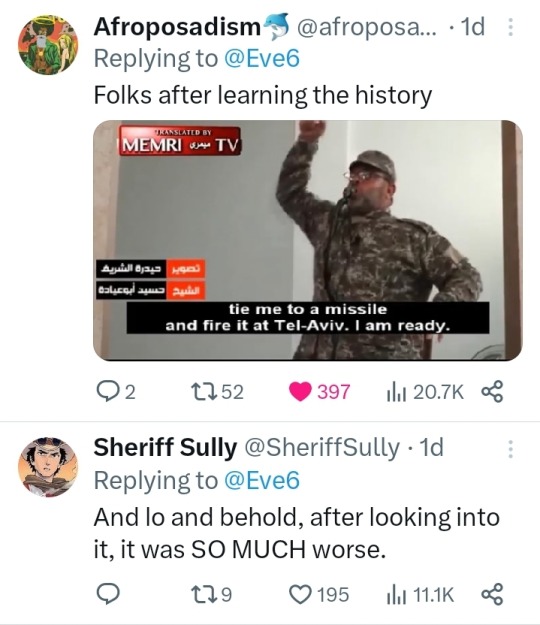


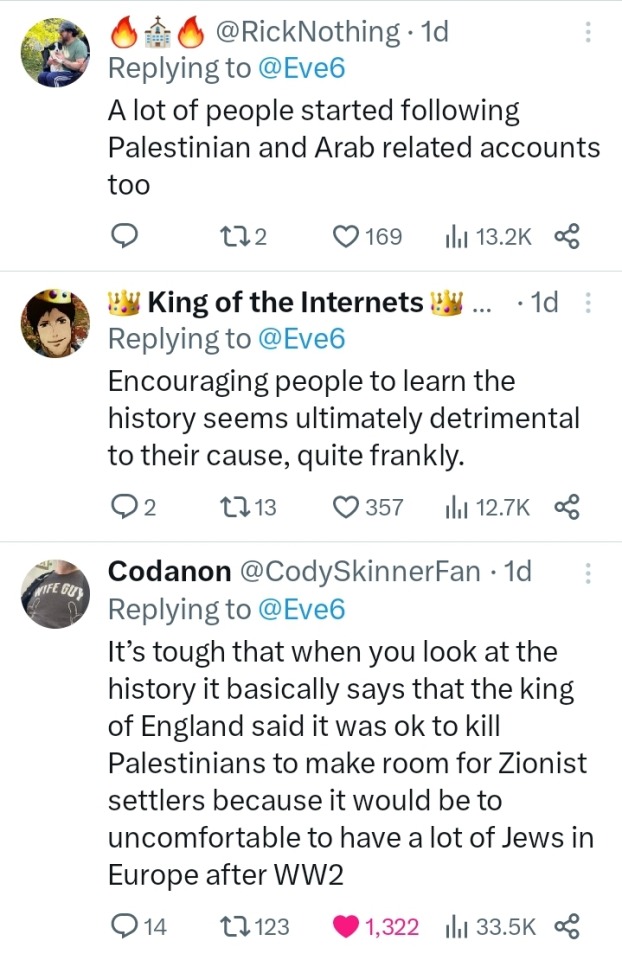
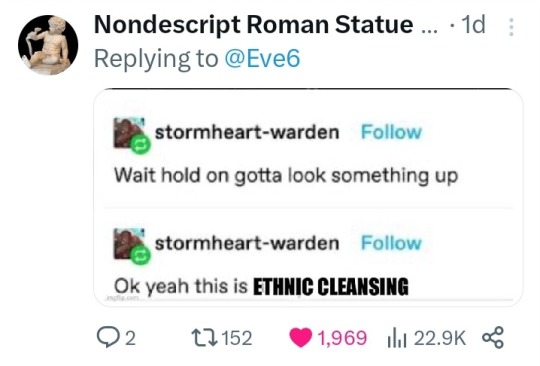
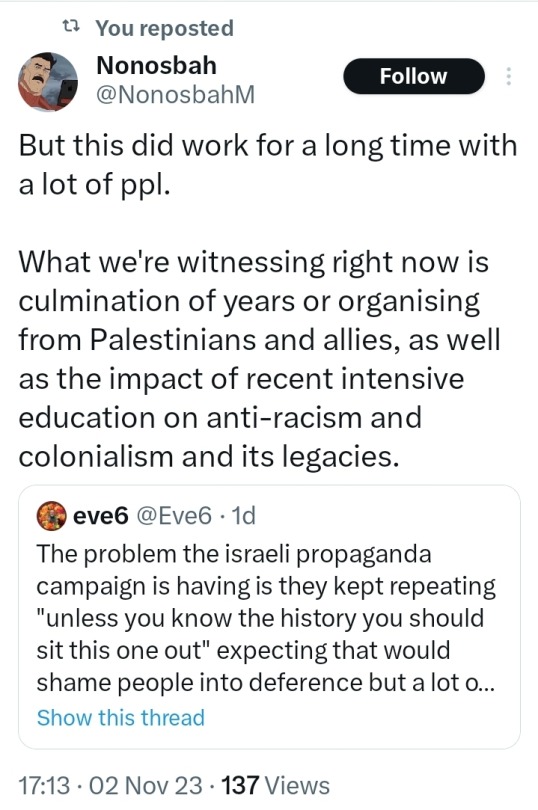
The Big Damn List Of Stuff They Said You Didn't Know
Five free eBooks on the colonization and ethnic cleansing of Palestine
Pluto Books Free Palestine Reading List 30-50% off
LGBT Activist Scott Long's Google Drive of Palestine Freedom Struggle Resources
(includes some of the reading material recced below)
The Cambridge UCU and Pal Society Resources List
List of Academic and Literary Books Compiled by Dr. Kiran Grewal
Academic Books (many available in Goldsmiths library)
Rosemary Sayigh (2007) The Palestinians: From Peasants to Revolutionaries, Bloomsbury
Ilan Pappé (2002)(ed) The Israel/Palestine Question, Routledge
(2006) The Ethnic Cleansing of Palestine, OneWorld Publications
(2011) The Forgotten Palestinians: A History of the Palestinians in Israel, Yale University Press
(2015) The Idea of Israel: A History of Power and Knowledge, Verso Books
(2017) The Biggest Prison on earth: A history of the Occupied territories, OneWorld Publications
(2022) A History of Modern Palestine, Cambridge University Press
Rashid Khalidi (2020) The Hundred Years’ War on Palestine: A History of Settler Colonialism and Resistance, 1917-2017, MacMillan
Andrew Ross (2019) Stone Men: the Palestinians who Built Israel, Verso Books
Ariella Azoulay and Adi Ophir (2012) The One-State Condition: Occupation and Democracy in Israel/Palestine, Stanford University Press.
Ariella Azoulay (2011) From Palestine to Israel: A Photographic Record of Destruction and State Formation, 1947-1950, Pluto Press
Jeff Halper (2010) An Israeli in Palestine: Resisting Dispossession, Redeeming Israel, Pluto Press
(2015) War Against the People: Israel, the Palestinians and Global Pacification
(2021) Decolonizing Israel, Liberating Palestine: Zionism, Settler Colonialism, and the Case for One Democratic State, Pluto Press
Anthony Loewenstein (2023) The Palestine Laboratory: How Israel exports the Technology of Occupation around the World (CURRENTLY FREE TO DOWNLOAD ON VERSO)
Noura Erakat (2019) Justice for some: law and the question of Palestine, Stanford University Press
Neve Gordon (2008) Israel’s Occupation, University of California Press
Joseph Massad (2006) The persistence of the Palestinian question: essays on Zionism and the Palestinians, Routledge Edward Said (1979) The Question of Palestine, Random House
Memoirs, Novels & Poetry:
Voices from Gaza - Insaniyyat (The Society of Palestinian Anthropologists)
Letters From Gaza • Protean Magazine
Raja Shehadeh (2008) Palestinian Walks: forays into a Vanishing Landscape, Profile Books
Ghada Karmi (2009) In Search of Fatima: A Palestinian Story, Verso Books
Fatma Kassem (2011) Palestinian Women: Narratives, histories and gendered memory, Bloombsbury
Mourid Barghouti (2005) I saw Ramallah, Bloomsbury
Izzeldin Abuelaish (2011) I Shall Not Hate: A Gaza Doctor’s Journey on the Road to Peace and Human Dignity, Bloomsbury
Cate Malek and Mateo Hoke (eds)(2015) Palestine Speaks: Narrative of Life under Occupation, Verso Books
The Works of Mahmoud Darwish
Human Rights Reports & Documents
Information on current International Court of Justice case on ‘Legal Consequences arising from the Policies and Practices of Israel in the Occupied Palestinian Territory, including East Jerusalem’
UN Commission of Inquiry Report 2022
UN Special Rapporteur Report on Apartheid 2022
Amnesty International Report on Apartheid 2022
Human Rights Watch Report on Apartheid 2021
Report of the United Nations Fact-Finding Mission on the Gaza Conflict’ 2009 (‘The Goldstone Report’)
Advisory Opinion on the Legal Consequences of the Construction of a Wall in the Occupied Palestinian Territory, International Court of Justice, 9 July 2004
Films
Lemon Tree (2008)
Where Should The Birds Fly (2013)
Naila and the Uprising (2017)
Waltz with Bashir (2008)
Omar (2013)
Paradise Now (2005)
5 Broken Cameras (2011)
The Gatekeepers (2012)
Foxtrot (2017)
Gaza Mon Amour (2020)
The Viewing Booth (2020)
Innocence (2022) - Innocence (2022) | IDFA Archive
The Village Under the Forest (2013)
Palestine Film Institute's films on Gaza
Abby Martin - Gaza Fights For Freedom (2019) | Full Documentary | Directed by Abby Martin
Dan Cohen - Gaza Fights Back | MintPress News Original Documentary
‘The Promise’, directed by Peter Kosminsky (2010) (4 part miniseries on the creation of Israel)
Sources:
https://www.972mag.com/
https://jewishcurrents.org/
Jadaliyya ‘Gaza in Context’ Series
Jadaliyya “War on Palestine” podcast - The War on Palestine Podcast: Episode 1
Border Chronicle, Interview with Israeli anthropologist Jeff Halper
NGOs
B’Tselem
Breaking the Silence
Al Haq
Palestinian Feminist Collective
Yesh Din
DAWN
Amnesty International
Human Rights Watch
Gisha
Forensic Architecture
Instagram Accounts
gazangirl
mohammedelkurd
khaledbeydoun
motaz_azaiza
wizard_bisan1
etafrum
sara_mardini963
Twitter(X) Accounts
@PalStudies - Institute for Palestine Studies
@medicalaidpal
@middleeastmatters
@KenRoth - former executive director of Human Rights Watch
@YairWallach - Reader in Israel Studies at SOAS
@ PhilipProudfoot - researcher on development, humanitarianism and Arab states
@btselem - Israeli human rights documentation centre
@MairavZ - Senior Israel-Palestine Analyst at Crisis Group
@rohantalbot - Director of Advocacy and Campaigns at MedicalAidPal
@sarahleah1 - Executive Director of DAWN (democracy and human rights in MENA)
@alhaq_org - Palestinian human rights organisation
@FranceskAlbs - UN Special Rapporteur on the Occupied Territories
@Yesh_Din - Israeli human rights organisation
@sfardm - Michael Sfard, Israeli Human Rights Lawyer
@EphstainItay - Israeli international humanitarian lawyer
@saribashi - Program director for Human Rights Watch (Israeli living in Palestine)
@Gisha_Access - Israeli NGO
@_ZachFoster - Historian
Share widely!
(if any links are broken let me know. Or pull up the current post to check whether it's fixed.)
From River To The Sea Palestine Will Be Free 🇵🇸🇵🇸🇵🇸
(I took the first video down because turns out the animator is a terf and it links to her blog. Really sorry for any distress.)
83K notes
·
View notes
Text
Doyle came to hate Holmes and killed him off in print only to be forced to revive him upon public demand. In documentary series “Killing Sherlock: Lucy Worsley on the Case of Conan Doyle” (3 x 60′), historian Lucy Worsley investigates the love-hate relationship in a parallel biography of Holmes and the man who created him.
To accompany the series, “Sherlock” creator Mark Gatiss, who has a tradition of adapting ghost stories for the BBC for Christmas, has adapted Doyle’s short story “Lot No. 249” (1 x 30’), starring Kit Harington and Freddie Fox. It revolves around a group of Oxford students, one of whom undertakes research into the secrets of ancient Egypt which become the talk of the college.
82 notes
·
View notes
Text

well we have
“Since when do you call me John?”
“You’d be surprised”
“No, I wouldn't.”
im contented enough
4 notes
·
View notes
Note
hi! do you happen to have a list of must-watch holmes adaptations? can we see it pleasee
Hi anon! This is a great question; the short answer is no I don't keep such a list because I'd like to see everything eventually and haven't yet. But can I make such a list? I can try.
Since your follow-up ask mentioned that you’re watching from a tjlc/BBC Sherlock perspective, I’ve added explanations for why many of these adaptations made the cut. Personally, I love the earlier black and white films; if this is less your glass of tea, the first ones to cut out are Barrymore and Wontner.
Oh! Edited to add: there are so many Sherlock Holmes adaptations I haven’t seen, and I’m aware that I’m dramatically under-representing those not performed in English. Please feel free to recommend your favourites if you don’t see them here.
ACTION!
1. Sherlock Holmes Baffled (1900) Why wouldn’t you start here? It was the first, has nothing to do with Sherlock Holmes whatsoever, and runs just under 1 minute.
2. Sherlock Holmes (1916). William Gillette as Holmes. Historically very important. This is the film version of an original play first written by Doyle, then destroyed in a fire, then rewritten by Gillette with Doyle’s permission. Remember “Marry him, kill him, do what you like with him”? That was about this play (1899). Gillette was the model for Collier’s illustrator Frederic Dorr Steele’s Sherlock Holmes (1903 onward). This film was thought lost for many years; the Hartswood gang partly funded its restoration when it was rediscovered. Holmes has a love interest in this, Alice Faulkner, who is I guess modelled on Irene Adler; IIRC, they share a dream or vision at some point, which got my attention. There are some nice Holmes & Watson bits, too, although Watson is barely in it.
3. Sherlock Holmes (1922) John Barrymore as Holmes. I like this one! Again, Watson is not much in it, which leads to some odd choices like Holmes sitting down and listing his own limits (why???), but we do see their rooms in... Cambridge (sure, why not)... so they’re young, which is rare enough, and there’s a bit of nice camaraderie there. The Moriarty special effects are hilarious.
4. Sherlock Jr. (1924) Buster Keaton as a bungling Holmes wannabe. It’s Buster Keaton, so it’s action-packed and funny, with the added bonus of an extended mind palace sequence and fourth wall breaks. I just think it’s neat.
5. Wontner films (1931-1937) Arthur Wontner as Holmes. At long last, sound! Wontner did several films as Sherlock Holmes, partnered with Ian Fleming (not that one) as Watson. I like these, too. The Sign of Four is often laughed at for the speedboat chase, but have you read The Sign of the Four? Of course there should be a speedboat chase. Also: hairline.
6. Rathbone/Bruce films (1939-1946) Basil Rathbone as Holmes. These are obviously essential. The first two are set in Victorian England; after they moved from 20th Century Fox to Universal, they ditched the fog and deerstalker to fight the Nazis. Sherlock references these films often. For example, the Golem in TGG is based on the Creeper from The Pearl of Death; the play in the aluminium crutch case on John’s blog is named for Terror by Night; Moriarty’s stair pause in TRF is based on that in The Woman in Green; Irene teasing Sherlock in disguise in ASIB is based on Adria Spedding doing the same in The Spider Woman. That’s off the top of my head; lots of people have written about these references on tumblr over the years. Oh right, Holmes nearly leaps off a building in The Woman in Green because Moriarty tells him to, so there’s that.
7. The Hound of the Baskervilles (1959) Peter Cushing as Holmes. This is the Hammer Films version, so it’s pulpy and lurid. Is it Sherlock Holmes or is it Dracula? I’m not sure even Cushing knows. Mark Gatiss is a huge Hammer fan; ‘nuff said. Meant to be enjoyed for its faults, rather than despite them.
8. The Private Life of Sherlock Holmes (1970) Robert Stephens as Holmes. Surely I don’t need to explain this one. The first on-screen gay Holmes (some would say this is arguable; I’m not going to bother arguing).
9. The Seven-Per-Cent Solution (1976) Nicol Williamson as Holmes. This is not a great film, but I’m giving it a mention because the pastiche it was based on (by Nicholas Meyer, who also wrote Star Trek: Wrath of Khan, with all its Sherlockian vibes) is a pretty big deal. It’s got Freud! It’s got cocaine! The film has some good moments in it, though the book is better; the ending was changed from book to screen and a het romance was tacked on, because of course it was.
10. Murder by Decree (1979) Christopher Plummer as Holmes. Does a thing with peas.
11. Lenfilm Holmes (1980-1988) Vasily Livanov as Holmes. This is so well done; really essential viewing. Vitaly Solomin is wonderful as Watson. Tea?
12. Granada Holmes (1984-1994) Jeremy Brett as Holmes. Again, essential viewing. Don’t underestimate the film-length episodes at the end of the series; Sherlock references these more than most because it’s where the original contributions are. A huge caveat here: Granada’s approach was to usually remove Watson’s narration, and show the viewer events that are only told in the stories, and often filtered through multiple people. So, when you’re watching the episodes, you pretty much can’t help but accept all events as factual, whereas the same cannot be assumed in the stories at all. In my opinion, this is the biggest limitation of the Granada series. They do make up for this with creative framing and lighting; pay attention to mirrors, for example, which are used to great effect throughout the series. And when they choose to diverge from the original story, it’s often to do something quite interesting. But I’d strongly recommend reading the story before watching the episode, so that you can see how they changed it every time; there is a real tendency for people (and like... the Granada fans are quite zealous about this) to just assume that everything Granada did was exactly canonical, and it’s simply not. I’ll also point out that the series was mainly produced by Michael Cox, who also commissioned the Oxford World’s Classics editions of the Holmes stories, which were annotated by a team of very smart people, including Richard Lancelyn Green. Cox also wrote a biography of MR James. Anyway, he knew his stuff, and it shows in the non-canonical places, in the divergences from canon.
13. The Great Mouse Detective (1986) Barrie Ingham voicing Basil of Baker Street. No explanation needed.
14. Without a Clue (1988) Michael Caine as Holmes. This is mostly here for Amy! It’s revealed early in this film that Watson is the brains behind the operation. Personally, I prefer The Adventures of Sherlock Holmes’s Smarter Brother (1975) in the “Holmes isn’t smart actually” genre, but only because I think Gene Wilder is funnier than Michael Caine.
15. A Case of Evil (2002) James D’Arcy as Holmes. I’m sorry, this has no place on a must-watch list, but it’s one of two so-bad-it’s-somehow-something films that I’m including (yes, you know what the other one is). It’s all repressed trauma and spooky dreams, I can’t leave it out.
18. The Hound of the Baskervilles (2002) Richard Roxburgh as Holmes. Ok, again, I apologize, but this is the only Hound film among over 30 to nail the tone of the book as far as Holmes and Watson are concerned—to recognize that the point of the book is that Holmes deserted Watson and now he’s back (yes, I’m aware the novel is backdated, it doesn’t matter). The only one! The casting is not great, it’s got some other issues, but it deserves more credit than it gets.
17. Reichenbach Falls (2007) Alec Newman as Detective Inspector John Buchan, who is somehow both a Holmes and a Watson. Required viewing; if you haven’t seen it, then hell mend you. I wrote an enormous meta on this film a few years ago.
18. Sherlock Holmes (2009) Robert Downey Jr. as Holmes. I said what I said.
19. Sherlock Holmes (2010) Ben Syder as Holmes. Awful. Frankly appalling. But may I also submit: Dinosaurs. And robots. It’s a fun time, especially with friends, and by now I really have convinced myself that Steven Moffat based the Doctor Who episode Deep Breath on it.
20. Sherlock (2010-) Benedict Cumberbatch as Holmes. Eyyyyyy.
21. New Russian Holmes (2013) Igor Petrenko as Holmes. Full disclosure, I haven’t watched this yet. I need to rectify that soon.
22. Miss Sherlock (2018) Yûko Takeuchi as Holmes. What a tragic loss; this was a wonderful series and she was brilliant in it. Saw what BBC Sherlock was doing and tried to beat it to the punch. I have to respect that.
91 notes
·
View notes
Note
Hi! You mentioned it, so I wanted to ask: which biography of Wilde do you recommend? And maybe some book on queerness in 19th century England (especially the 90s) in general? Sorry to bother, I’m just writing my thesis on something related to this :-)))
Hi anon! The current bible is Oscar: A Life by Matthew Sturgis (2018). If you’re extra keen, The Complete Letters of Oscar Wilde was published in 2000.
I haven’t done a lot of general reading on queerness in 19th century England, but these are on my bookshelf (by author):
Queer City: Gay London from the Romans to the Present Day (Peter Ackroyd)
London and the Culture of Homosexuality, 1885–1914 (Matt Cook)
On Queer Street: A Social History of British Homosexuality, 1895-1995 (Hugh David)
Sexual Heretics: Male Homosexuality in English Literature from 1850 to 1900 (Brian Reade)
Strangers: Homosexual Love in the Nineteenth Century (Graham Robb)
I know I have a few others, but unfortunately half of my books are stacked in another room while I paint, so I’m going by memory + google. The Ackroyd is sort of harshly entertaining, but not particularly useful for research. Definitely hit up your university library, though - they may have other good things and can always borrow books from other libraries for you if they don’t have what you want on the shelves.
Re. your follow-up question on “transsexuality and androgyny”, I have no resources for this, but maybe some of my followers can offer something?
ETA: I can’t believe I forgot to mention Eve Kosofsky Sedgwick! Definitely check out her Epistemology of the Closet (which is only partly on Victorian writers) and Between Men: English Literature and Male Homosocial Desire, which is probably a better fit.
23 notes
·
View notes
Text
Appointment in Samsara Part 2: Secret Twins, Through the Looking-Glass
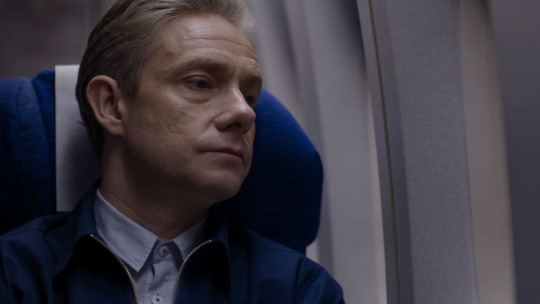
A re-examination of the show within the context of fatalism, the Ghost Driver, and Secret Twins.
Preview:
In order to know what our Storyteller has gotten up to and what it means, we have to look back at all the many examples of the Car and Driver metaphor throughout the show. You likely already have an interpretation for a lot of these examples. However, in many if not all, there exist double readings — secret twins. Let us begin with an honorable mention: The Gay Pilot, the gift that keeps on giving.
John: You haven’t eaten today? For God’s sake, you need to eat. Sherlock: No, you need to eat. I need to think. The brain’s what counts. Everything else is transport. John: You might consider refueling. … John: So, you don’t…do…anything. Sherlock: Everything else is transport.
The body is transport. We also learn throughout the show that food is sex, refueling the body like you refuel your car to keep it running. Similar to Julian English in Appointment in Samarra, one’s sexuality is one’s vitality.
There are cars that pass like ghosts, unseen, unremembered. There are people we trust, always, when we’re alone, when we’re lost, when we’re drunk. We never see their faces, but every day we disappear into their cars and let the trap close around us. I give you the perfect murder weapon of the modern age: the invisible car.
Read the rest on Medium
Need to read Part 1? Find that here.
85 notes
·
View notes
Text
Landed on a Portsmouth Jetty
This is a collection of words by Arthur Conan Doyle in different works about the events surrounding his move to Portsmouth, where he lived from 1882 to 1890, struggling to build a medical practice following his betrayal by George Turnavine Budd.
By the way, an extraordinary card arrived from Cullingworth during my absence. “You are my man,” said he; “mind that I am to have you when I want you.” There was no date and no address, but the postmark was Bradfield in the north of England. Does it mean nothing? Or may it mean everything? We must wait and see.
— Arthur Conan Doyle, The Stark Munro Letters (1895)
Doyle and Budd were friends at the University of Edinburgh; in 1882, Budd convinced Doyle to join his thriving practice in Plymouth, where they worked together for just six weeks, until suspicion, driven by critical letters by Mary Doyle (Arthur’s mother), drove them apart. Although their time together was short, these events influenced Doyle greatly; Budd was an important partial inspiration for Sherlock Holmes, Professor Challenger, and many other Doyle characters. Their relationship was the subject of Doyle’s 1895 novel The Stark Munro Letters [x] [x].
It occurs to me that many of the deductions Sherlock makes about Faith in The Lying Detective resemble events from this period of Doyle’s life.

Presumably you downsized when you … when you left your job … and maybe when you ended your relationship. There wasn’t anything physical going on, was there? Quite some time, in fact. (The Lying Detective)
In a book written some years afterwards called The Stark Munro Letters, I drew in very close detail the events of the next few years, and there the curious reader will find them more clearly and fully set out than would be to scale in these pages. […] the whole history of my association with the man [George Turnavine Budd] whom I called Cullingworth, his extraordinary character, our parting and the way in which I was left to what seemed certain ruin, were all as depicted.
— Arthur Conan Doyle, Memories and Adventures (November 1923)
There are two [letters], the fifth and the ninth, from which some excisions are necessary; but in the main I hope that they may be reproduced as they stand.
— Arthur Conan Doyle, The Stark Munro Letters (1895)
He was a man born for trouble and adventure, unconventional in his designs and formidable in his powers of execution—a man of action with a big but incalculable brain guiding the action. […] For some reason he took a fancy to me, and appeared to attach an undue importance to my advice. […]
People flocked into the town from 20 and 30 miles round, and not only his waiting-rooms, but his stairs and his passages, were crammed. His behaviour to them was extraordinary. He roared and shouted, scolded them, joked them, pushed them about, and pursued them sometimes into the street, or addressed them collectively from the landing. A morning with him when the practice was in full blast was as funny as any pantomime and I was exhausted with laughter. […]
— Arthur Conan Doyle, Memories and Adventures (November 1923)

That was the most ridiculous thing I’ve ever done. (A Study in Pink)
Doyle unmoored, under the cut.
Keep reading
162 notes
·
View notes
Text
Landed on Portsmouth Jetty
This is a collection of words by Arthur Conan Doyle in different works about the events surrounding his move to Portsmouth, where he lived from 1882 to 1890, struggling to build a medical practice following his betrayal by George Turnavine Budd.
By the way, an extraordinary card arrived from Cullingworth during my absence. “You are my man,” said he; “mind that I am to have you when I want you.” There was no date and no address, but the postmark was Bradfield in the north of England. Does it mean nothing? Or may it mean everything? We must wait and see.
— Arthur Conan Doyle, The Stark Munro Letters (1895)
Doyle and Budd were friends at the University of Edinburgh; in 1882, Budd convinced Doyle to join his thriving practice in Plymouth, where they worked together for just six weeks, until suspicion, driven by critical letters by Mary Doyle (Arthur’s mother), drove them apart. Although their time together was short, these events influenced Doyle greatly; Budd was an important partial inspiration for Sherlock Holmes, Professor Challenger, and many other Doyle characters. Their relationship was the subject of Doyle’s 1895 novel The Stark Munro Letters [x] [x].
It occurs to me that many of the deductions Sherlock makes about Faith in The Lying Detective resemble events from this period of Doyle’s life.

Presumably you downsized when you … when you left your job … and maybe when you ended your relationship. There wasn’t anything physical going on, was there? Quite some time, in fact. (The Lying Detective)
In a book written some years afterwards called The Stark Munro Letters, I drew in very close detail the events of the next few years, and there the curious reader will find them more clearly and fully set out than would be to scale in these pages. […] the whole history of my association with the man [George Turnavine Budd] whom I called Cullingworth, his extraordinary character, our parting and the way in which I was left to what seemed certain ruin, were all as depicted.
— Arthur Conan Doyle, Memories and Adventures (November 1923)
There are two [letters], the fifth and the ninth, from which some excisions are necessary; but in the main I hope that they may be reproduced as they stand.
— Arthur Conan Doyle, The Stark Munro Letters (1895)
He was a man born for trouble and adventure, unconventional in his designs and formidable in his powers of execution—a man of action with a big but incalculable brain guiding the action. […] For some reason he took a fancy to me, and appeared to attach an undue importance to my advice. […]
People flocked into the town from 20 and 30 miles round, and not only his waiting-rooms, but his stairs and his passages, were crammed. His behaviour to them was extraordinary. He roared and shouted, scolded them, joked them, pushed them about, and pursued them sometimes into the street, or addressed them collectively from the landing. A morning with him when the practice was in full blast was as funny as any pantomime and I was exhausted with laughter. […]
— Arthur Conan Doyle, Memories and Adventures (November 1923)

That was the most ridiculous thing I’ve ever done. (A Study in Pink)
Doyle unmoored, under the cut.
Keep reading
162 notes
·
View notes
Text
youtube
Seeing gifs of Stoll Pictures 1921 silent film adaptation of The Devil’s Foot reminded me that the entire film is available on YouTube, for anybody who’s interested! It’s only 27 minutes long, and despite the poor picture quality, it is in my opinion worth watching. Eille Norwood as Holmes is rather grim for my tastes, but he has a striking presence, and Hubert Willis’s Watson is generally sidelined but is not played as a fool, which counts for something. Besides, this is the earliest adaptation of The Devil’s Foot, featuring a nearly century-old Holmes and Watson strolling together through the country, and at least one solid scene of them functioning as partners on the job.
If nothing else, I recommend watching 15:30–17:00, which covers Holmes’s ignition of the poison and the aftermath. In the hight of the danger each is clearly working for the safety of the other in the midst of their dazed panic, and the moments that follow are surprisingly tender. Watch carefully—due to the darkness of the picture one can see little more than a flash of white by Watson’s cheek, but @thespiritualmultinerd and I, with tentative support from @tremendousdetectivetheorist, are very nearly convinced that Holmes lays a gentle hand on Watson’s face.
176 notes
·
View notes
Text
Terror by Night
– analysing John’s blog post ”The Aluminium Crutch”
Two different characters in the show – Harry, the equerry from Buckingham Palace in ASiB, and Dr. Frankland, the murderer in THoB - acknowledge this case on John’s blog as particularly interesting.


But – surprisingly perhaps – this crime case is never shown or even mentioned by Sherlock or John in the actual show. So why not have a closer look on The Aluminium Crutch here instead? Surely this must have been analysed in metas before, but since I don’t know of any at the moment (forgive me if I’ve missed something!), I’ll give it a try.
The crime case takes place in a theatre where Sherlock watches the play “Terror by Night”. Since John isn’t present (he’s on a date), Sherlock describes the whole case to him on his voice mail, which John then transcribes verbatim to his blog. So this time we have Sherlock’s own account of the case directly in the blog post.
Case summary: There’s a murder committed on stage. The actor Matthew Michael, playing Detective Sidney Paget who in the play is investigating the murder of Lady Margaret Chaplette, gets hit with an aluminium crutch – supposed to be a rubber props - and dies. The actor William Howells, playing Albert Chaplette, the lady’s son and also murderer, is the one who hits Michael with the crutch.
Since Sherlock’s voice mail account might be a bit complicated to follow, I’ve made a little table to structure it up:

Sherlock narrows down the possible suspects to – surprise – Matthew Michael himself! He had substituted the rubber aluminium crutch for a real one, hoping to get the misbehaving and drunk actor Howells to be fired for breaking his arm or something similar, but his plan backfired and he received a fatal blow to the head. So the point of this is that the victim actually caused his own death.
Some ‘features of interest’:
Keep reading
196 notes
·
View notes
Note
i’ve seen so many people talking abt how bbc sherlock mischaracterized them & their relationship, making them seem like they can’t stand each other. i don’t believe it but i wanna ask why did mofftiss make it like “that” 🫠
My take is that Sherlock is Mofftiss' attempt to transform the subtext of the canon stories into text. This means that rather than telling any specific Doyle story directly, they're trying to tell an underlying story that appears in that canon story in a way that makes it look like a new invention to any casual viewer, but is actually true to Doyle's intention in the original story.
As a consequence, where Doyle creates a side character who is a mirror to either Holmes or Watson, Mofftiss will either eliminate (or duplicate) the middleman by giving their traits/story to directly to Sherlock or John in Sherlock. They actually do this both in subtext and in text.
So, for example, subtextual violence by a John mirror toward a Sherlock mirror in the canon (let's use Culverton Smith as a Watson mirror in The Dying Detective because it's an unusually clear example) becomes textual violence by John toward Sherlock in The Lying Detective. Mofftiss were unusually obvious with this one; Doyle literally has Watson's first observations of Culverton Smith occur through a mirror. Smith turns the full power of his medical knowledge against Sherlock Holmes just as Holmes is telling Watson that he doesn't think he's a good doctor. Smith shakes Holmes roughly as he lies in his sick bed, while Watson hides. It's very easy to see the roots of The Lying Detective in this story.
In my view, there isn't really a way to convince canon readers who aren't interested in this kind of reading, and I'm not interested in doing that. Doyle was predominantly a horror writer, and he appears to have had a lot of hangups that he expressed in his fiction (I don't just mean his relationship with sexuality, but that's part of it). It shouldn't be surprising that the subtext of these stories takes some dark turns. There is absolutely nothing wrong with reading the canon for the witty banter and the derring-do! Holmes and Watson can just be crime-solving husbands if you want, and the cases can just be the cases. But it's clear to me that Doyle hid stories within his stories, and now that I've seen that, I want to uncover as much of it as I can because I find it fascinating and fun to work out.
Despite that, I wouldn't personally characterize John and Sherlock's (or Watson and Holmes's) relationship as "they can't stand each other", and clearly Mofftiss don't either, it only takes watching the entirety of TLD to see that. I also find it a bit boring to reduce Martin Freeman's performance in that episode to only one emotion (that's famously the opposite of what he does in his acting!). Their relationship is complex, and John's deeply repressed emotions are getting in the way of their sorting it out onscreen.
43 notes
·
View notes
Note
What do you think of Mrs. Hudson’s role in Sherlock tho? Like since Una Stubbs has (sadly) passed away, can her role be replaced by another character through mirror characters? Or would they need to have another person play that role?
Hi anon,
Of course it's devastating to lose Una Stubbs as Mrs Hudson, and it's much harder for those involved in the show, who knew her personally, than it is for us.
In the Sherlock universe, I think the most obvious way to deal with the loss of Mrs Hudson as a character would be to cast a new actress as Mrs Turner, and have her appear as the 221B landlady without explanation. This would mirror Doyle's occasional use of Mrs Turner instead of Mrs Hudson.
The 221B landlady is unnamed when she first appears in A Study in Scarlet (1887), and then named Mrs Hudson in the next novel, The Sign of Four (1890). Despite this, she is named Mrs Turner throughout the first short story, A Scandal in Bohemia (1891). Much later, Mrs Turner is lined out in an early draft of The Empty House (1903), and replaced by Mrs Hudson:

Interestingly, there are varied theories about how long Mrs Hudson remained at 221B. Many Sherlockians believe that the old woman named Martha in His Last Bow (1917), described by Sherlock Holmes as "the only servant I have left", is actually Mrs Hudson, even though her last name is not given, and bringing Mrs Hudson along for undercover work at the German spy Von Bork's house seems a bit presumptuous. In Sherlock, this story is largely incorporated into His Last Vow (hardly surprising, given the title), and several of Von Bork's traits are incorporated into Magnussen's character. In the ACD Sherlock Holmes universe, this would place Mrs Hudson at the latest point in the timeline, dated at 1914 (it will be the last story in Letters From Watson).
However, the mention of a "new cook" in the Case-Book story Thor Bridge (1922), which Sherlock also borrows from in His Last Vow, as well as in S4, has led some Sherlockians to speculate that Mrs Hudson is no longer at 221B by that point.
"There is little to share, but we may discuss it when you have consumed the two hard-boiled eggs with which our new cook has favoured us. Their condition may not be unconnected with the copy of the Family Herald which I observed yesterday upon the hall-table. Even so trivial a matter as cooking an egg demands an attention which is conscious of the passage of time, and incompatible with the love romance in that excellent periodical." (Holmes to Watson in Thor Bridge)
In Sherlock, the role of Jane, the inattentive maid in The Abominable Bride, appears to be borrowed partly from Watson's maid Mary Jane, who cuts his boots while scraping mud off them in A Scandal in Bohemia, and the new cook who can't boil an egg in Thor Bridge.
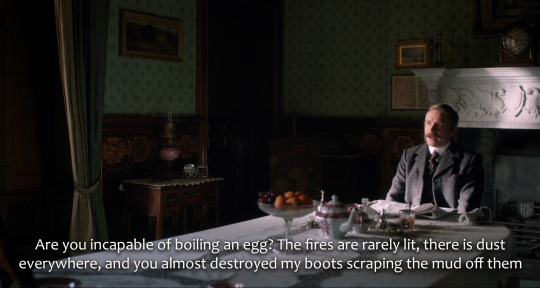
The thing is, in the ACD Sherlock Holmes universe, Mrs Hudson is the cook; this is not in dispute. So, the reference to a "new cook" suggests to some that Mrs Hudson may have passed away sometime before Thor Bridge, which would mean that Martha cannot be Mrs Hudson if you take the dates seriously.
None of this directly answers your question, but my point is, the Great Game presents some interesting considerations for addressing the appearance of a new landlady for 221B. They may choose not to address it at all, swapping in a Mrs Turner for Mrs Hudson without comment, as Doyle did, or they may choose to mention the death of the character directly, or they may choose something else. Their method is pretty flexible, and they have options because of the way that Doyle wrote and the way that his stories have been interpreted over time. There is some ambiguity around Mrs Hudson as a character in the later stories; I assume they will lean into that, though I could easily be wrong.
39 notes
·
View notes
Note
Anon (who's not delusional) here, lol.
Thank you, guys. I didn't know that Moffat said that in January! Now I feel much better 😄
💙
7 notes
·
View notes
Text
grumbling about emp tags on my posts, grumbling more as i acknowledge that the productive outlet for this is to finish my meta
15 notes
·
View notes